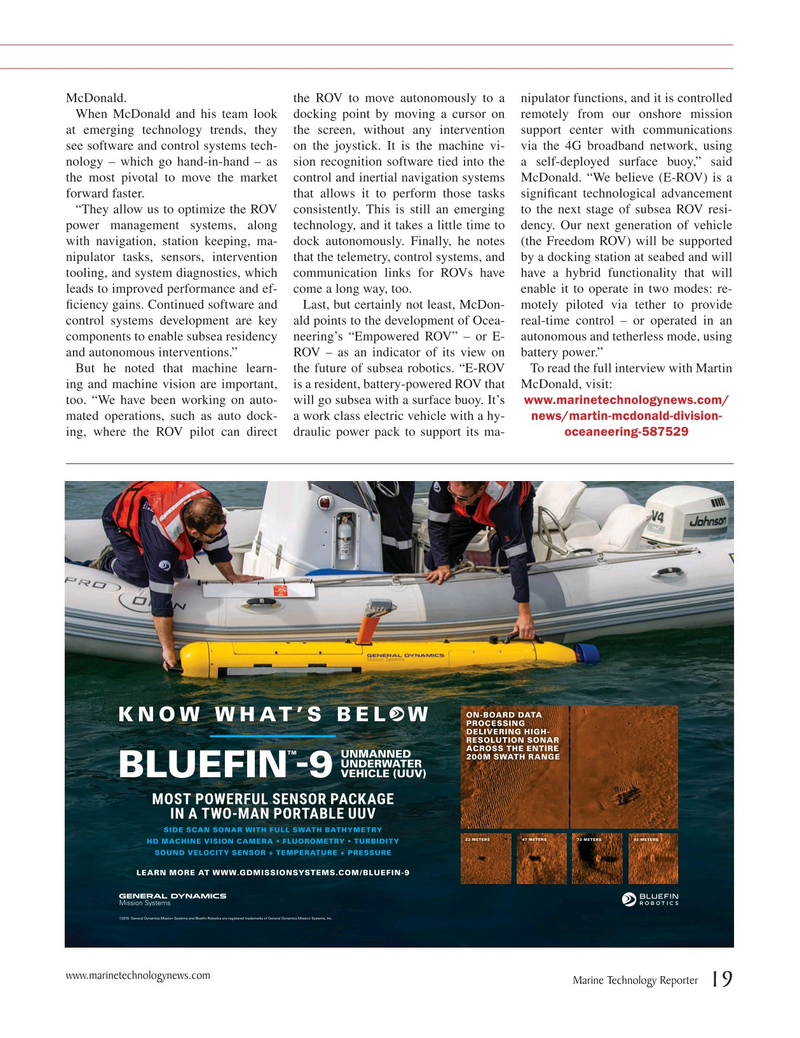
Page 19: of Marine Technology Magazine (July 2019)
MTR White Papers: Hydrographic
Read this page in Pdf, Flash or Html5 edition of July 2019 Marine Technology Magazine
McDonald. the ROV to move autonomously to a nipulator functions, and it is controlled
When McDonald and his team look docking point by moving a cursor on remotely from our onshore mission at emerging technology trends, they the screen, without any intervention support center with communications see software and control systems tech- on the joystick. It is the machine vi- via the 4G broadband network, using nology – which go hand-in-hand – as sion recognition software tied into the a self-deployed surface buoy,” said the most pivotal to move the market control and inertial navigation systems McDonald. “We believe (E-ROV) is a forward faster. that allows it to perform those tasks signi? cant technological advancement “They allow us to optimize the ROV consistently. This is still an emerging to the next stage of subsea ROV resi- power management systems, along technology, and it takes a little time to dency. Our next generation of vehicle with navigation, station keeping, ma- dock autonomously. Finally, he notes (the Freedom ROV) will be supported nipulator tasks, sensors, intervention that the telemetry, control systems, and by a docking station at seabed and will tooling, and system diagnostics, which communication links for ROVs have have a hybrid functionality that will leads to improved performance and ef- come a long way, too. enable it to operate in two modes: re- ? ciency gains. Continued software and Last, but certainly not least, McDon- motely piloted via tether to provide control systems development are key ald points to the development of Ocea- real-time control – or operated in an components to enable subsea residency neering’s “Empowered ROV” – or E- autonomous and tetherless mode, using and autonomous interventions.” ROV – as an indicator of its view on battery power.”
But he noted that machine learn- the future of subsea robotics. “E-ROV To read the full interview with Martin ing and machine vision are important, is a resident, battery-powered ROV that McDonald, visit: too. “We have been working on auto- will go subsea with a surface buoy. It’s www.marinetechnologynews.com/ mated operations, such as auto dock- a work class electric vehicle with a hy- news/martin-mcdonald-division- ing, where the ROV pilot can direct draulic power pack to support its ma- oceaneering-587529
ON-BOARD DATA
KNOW WHAT’S BEL W
PROCESSING
DELIVERING HIGH-
RESOLUTION SONAR
ACROSS THE ENTIRE 200M SWATH RANGE
MOST POWERFUL SENSOR PACKAGE
IN A TWO-MAN PORTABLE UUV
SIDE SCAN SONAR WITH FULL SWATH BATHYMETRY 22 METERS 72 METERS 47 METERS 92 METERS
HD MACHINE VISION CAMERA • FLUOROMETRY • TURBIDITY
SOUND VELOCITY SENSOR + TEMPERATURE + PRESSURE
LEARN MORE AT WWW.GDMISSIONSYSTEMS.COM/BLUEFIN-9 ©2019. General Dynamics Mission Systems and Blue?n Robotics are registered trademarks of General Dynamics Mission Systems, Inc.
www.marinetechnologynews.com
Marine Technology Reporter 19
MTR #6 (18-33).indd 19 7/31/2019 3:57:35 PM

 18
18

 20
20
